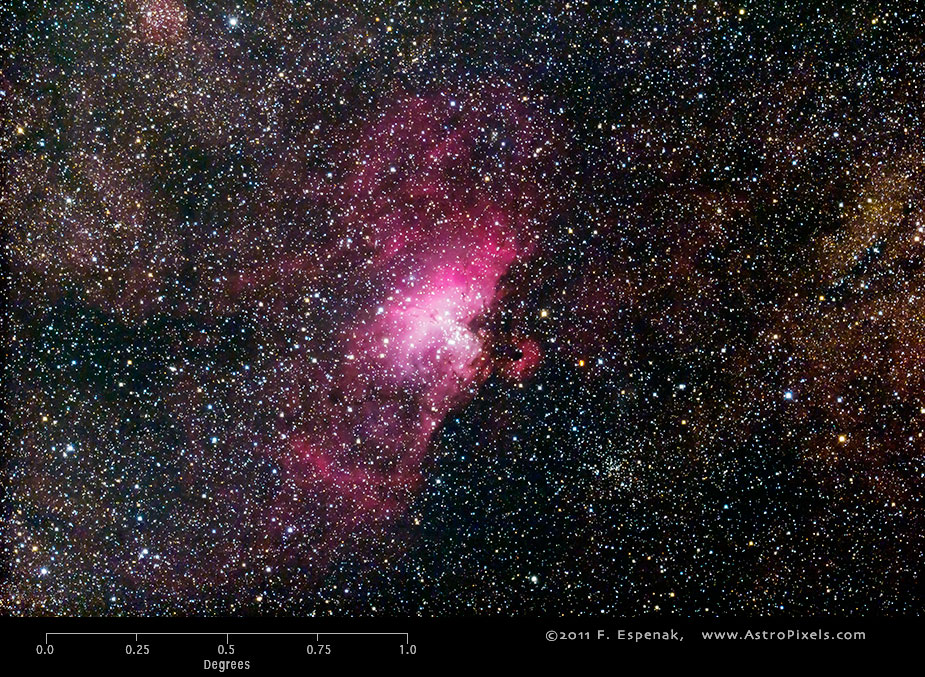
M16 - Eagle Nebula
Messier 16 or M16 (also designated NGC 6611) is a nebula and star cluster in the constellation Serpens. It has an apparent visual magnitude of 6.4 and its angular diameter is 7 arc-minutes. M16 lies at an estimated distance of 7000 light years. The Equinox 2000 coordinates are RA= 18h 18.8m, Dec= -13° 47´ which makes M16 best seen during the summer. The Messier Summer Star Chart shows the position of all Messier objects visible during that season. As one of the more famous objects in the Messier Catalog, it is commonly known as the Eagle Nebula.
The image above shows the uncropped view of M16 through the Takahashi E-180 Astrograph (North is to right). A 3x enlargement of this image appears to the right.
In spite of its inclusion in the Messier Catalog, the star cluster portion of M16 was actually discovered by J-P. de Chéseaux in 1746. Messier did not notice the nebula but only recorded the star cluster. E. E. Barnard was probably the first to photograph the Eagle Nebula in 1895. It was designated as IC 4703 in 1908. The Eagle Nebula is a region of star formation. Its glowing hydrogen gas is due to excitation from ultraviolet radiation emitted by hot young stars embedded in the nebula. According to Kharchenko et al. (2005), the distance of M16 is 5600 light years and its diameter is 35 light years. It contains 376 stars and its estimated age is 2-6 million years.
For more information, see the Messier Catalog as well as specific entries for M16 in Wikipedia and SEDS.
Messier's Description of M16
June 3, 1764
`A cluster of small stars, enmeshed in a faint glow, near the tail of Serpens, at little distance to the parallel of Zeta of this constellation; with an inferior telescope this cluster appears like a nebula.' (diam. 8')
Technical Details
- Object: M16
- Other Names: NGC 6611, Eagle Nebula
- Object Type: nebula and star cluster
- Object Data: Apparent Magnitude = 6.4, Angular Size = 7 arc-minutes
- Object Position (Equinox 2000): RA= 18h 18.8m, Dec= -13° 47´, Constellation = Serpens
- Date/Time: 2011 Aug 02 at 05:57 UTC
- Location: Bifrost Astronomical Observatory, Portal, AZ
- Mount: Astro-Physics 1200GTO
- Telescope: Takahashi Epsilon 180 Hyperbolic Astrograph
- Camera: Canon EOS 550D (Rebel T2i) (modified with a Baader UV/IR filter)
- Field of View: 1.70° x 2.56° at 1.7 arc-sec/pixel (web version: 10.0 arc-sec/pixel)
- Exposure: 4 x 300s, f/2.8, ISO 800
- File Name: M16-01w.jpg
- Processing (Adobe Camera Raw): Graduated Filter, Vignetting Correction, Noise Reduction, White Balance, Curves
- Processing (Photoshop CS5): Average Images, Curves, Noise Reduction
- Original Image Size: 3454 × 5179 pixels (17.9 MP); 11.5" x 17.3" @ 300 dpi
- Rights: Copyright 2011 by Fred Espenak. All Rights Reserved. See: Image Licensing.
